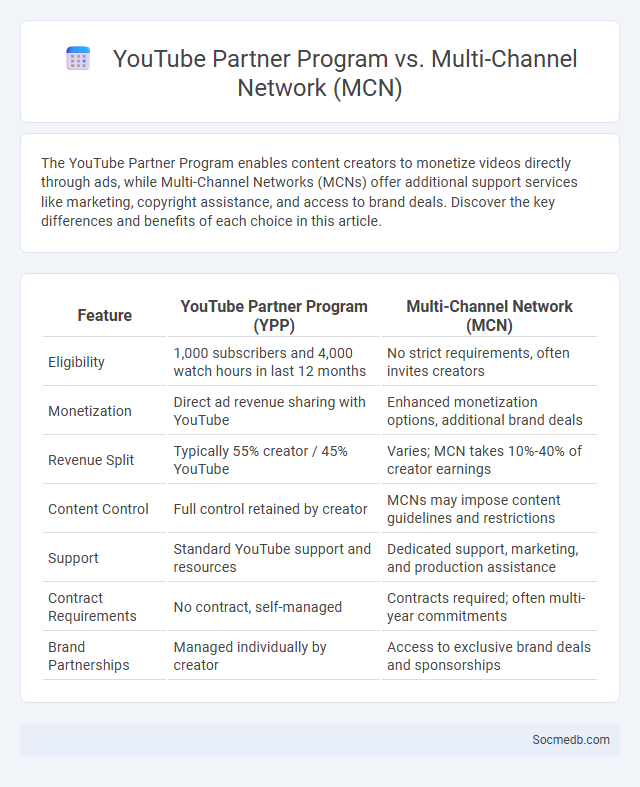
Photo illustration: YouTube Partner Program vs Multi-Channel Network (MCN)
The YouTube Partner Program enables content creators to monetize videos directly through ads, while Multi-Channel Networks (MCNs) offer additional support services like marketing, copyright assistance, and access to brand deals. Discover the key differences and benefits of each choice in this article.
Table of Comparison
| Feature | YouTube Partner Program (YPP) | Multi-Channel Network (MCN) |
|---|---|---|
| Eligibility | 1,000 subscribers and 4,000 watch hours in last 12 months | No strict requirements, often invites creators |
| Monetization | Direct ad revenue sharing with YouTube | Enhanced monetization options, additional brand deals |
| Revenue Split | Typically 55% creator / 45% YouTube | Varies; MCN takes 10%-40% of creator earnings |
| Content Control | Full control retained by creator | MCNs may impose content guidelines and restrictions |
| Support | Standard YouTube support and resources | Dedicated support, marketing, and production assistance |
| Contract Requirements | No contract, self-managed | Contracts required; often multi-year commitments |
| Brand Partnerships | Managed individually by creator | Access to exclusive brand deals and sponsorships |
Understanding YouTube Partner Program (YPP)
The YouTube Partner Program (YPP) enables content creators to monetize their videos by earning revenue through ads, channel memberships, and Super Chat. To qualify, your channel must have at least 1,000 subscribers and 4,000 watch hours in the past 12 months, complying with all YouTube policies. Joining YPP allows you to access advanced analytics and support, helping grow your audience and maximize earnings.
What Is a Multi-Channel Network (MCN)?
A Multi-Channel Network (MCN) is a company that partners with multiple YouTube creators to offer services like audience development, content programming, monetization, and brand partnerships. MCNs help creators optimize their channels by providing access to advanced analytics, copyright management, and advertising opportunities, enhancing Your revenue streams and online presence. These networks act as intermediaries between creators and platforms, enabling efficient growth and collaboration across social media channels.
Overview of YouTube Partner Program vs MCN
The YouTube Partner Program (YPP) enables creators to monetize their content directly through ads, channel memberships, and merchandise features, requiring eligibility criteria such as 1,000 subscribers and 4,000 watch hours in the past 12 months. Multi-Channel Networks (MCNs) are third-party organizations that manage multiple YouTube channels, offering additional services like audience development, brand partnerships, and technical support while taking a revenue share. YPP provides creators with direct control and revenues from their channel, whereas MCNs act as intermediaries providing expanded services but often at the cost of reduced revenue share and less autonomy.
Eligibility Requirements for YPP and MCNs
Eligibility for the YouTube Partner Program (YPP) requires at least 1,000 subscribers and 4,000 watch hours in the past 12 months to monetize content. Multi-Channel Networks (MCNs) offer creators management services but often require channels to meet specific criteria like consistent content quality and subscriber thresholds before partnership. Both YPP and MCNs help creators monetize and grow but operate under distinct eligibility standards.
Monetization Features: YPP vs MCN
Monetization features on social media differ significantly between the YouTube Partner Program (YPP) and Multi-Channel Networks (MCNs). YPP allows creators to earn revenue directly through ads, channel memberships, and Super Chats, providing more control and higher revenue share, while MCNs offer additional support services such as brand deals, cross-promotion, and content management but often take a substantial cut of earnings. Choosing between YPP and MCN depends on a creator's need for independence versus access to extended monetization tools and network resources.
Revenue Sharing and Payment Structures
Social media platforms implement diverse revenue sharing and payment structures to monetize user-generated content, often distributing a percentage of advertising revenue to creators based on engagement metrics like views, likes, and shares. Influencer marketing and brand partnerships further diversify income streams, with payments structured as fixed fees, commission-based, or performance-driven payouts. The shift toward subscription models and direct fan support through features like tipping and membership programs creates new financial opportunities, fostering sustainable content creation ecosystems.
Content Ownership and Creative Control
Social media platforms often have terms that impact content ownership, typically granting users a license to the platform while retaining creator rights. Maintaining creative control requires understanding platform policies and using tools to manage content distribution and modification. Content creators benefit from platforms that explicitly affirm ownership while providing options for monetization and rights protection.
Support and Resources: YPP Compared to MCN
YouTube Partner Program (YPP) offers creators direct access to dedicated support teams and comprehensive educational resources, including Creator Academy and personalized policy guidance. Multi-Channel Networks (MCNs) provide additional support such as channel management, brand partnerships, and monetization strategies but may take a percentage of revenue in exchange for these services. YPP's transparent support structure ensures creators retain control while leveraging YouTube's official resources, whereas MCNs offer layered support that can enhance growth but vary widely in effectiveness and contract terms.
Risks and Challenges of Joining an MCN
Joining a Multi-Channel Network (MCN) on social media can expose your YouTube channel to risks such as revenue sharing conflicts, loss of control over content, and restrictive contract terms that may limit your creative freedom. Many creators face challenges like insufficient support, hidden fees, or difficulties exiting the partnership, which can impact your channel's growth and monetization potential. Evaluating the benefits against these risks is crucial before committing to an MCN agreement.
Choosing the Right Partnership Model for Your Channel
Selecting the right partnership model for your social media channel hinges on aligning your brand values with potential collaborators, ensuring authentic engagement and audience resonance. Consider models such as influencer partnerships, brand sponsorships, or content co-creation, each offering distinct benefits like reach amplification, credibility building, or creative synergy. Analyzing audience demographics and engagement metrics provides data-driven insights to optimize partnership effectiveness and maximize return on investment.
 socmedb.com
socmedb.com